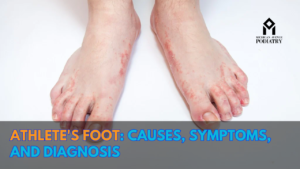Gout and bunions are both foot conditions that can cause pain and discomfort, but they are distinct in their causes, symptoms, and treatments. Differentiating between gout and bunions is essential for accurate diagnosis and effective management. In this informative guide, we’ll explore the differences between gout and bunions, their symptoms, treatment options, and when to seek help from a podiatrist or foot doctor.
Gout vs Bunion: Understanding the Difference
Understanding Gout: Gout is a type of inflammatory arthritis caused by the buildup of uric acid crystals in the joints, most commonly affecting the big toe. When uric acid levels in the blood are high, crystals can form and deposit in the joints, leading to sudden and severe pain, swelling, redness, and tenderness in the affected area. Gout attacks often occur at night and can be triggered by factors such as diet, alcohol consumption, obesity, and certain medications.
Understanding Bunions: Bunions, on the other hand, are bony protrusions that develop at the base of the big toe, causing the toe to point inward toward the other toes. Bunions typically form due to structural abnormalities in the foot, such as flat feet, wearing tight or narrow shoes, or genetic predisposition. Common symptoms of bunions include pain, swelling, redness, and difficulty wearing shoes comfortably, especially in the area where the bunion rubs against the shoe.
Distinguishing Between Gout and Bunions: While both gout and bunions can cause pain and swelling in the big toe area, there are key differences that can help distinguish between the two conditions:
- Onset and Duration: Gout attacks often come on suddenly and can last for several days to weeks, whereas bunions develop gradually over time and may become more symptomatic with prolonged pressure or activity.
- Appearance: Gout typically presents with intense redness, swelling, and warmth around the affected joint, whereas bunions appear as a bony bump at the base of the big toe.
- Triggers: Gout attacks can be triggered by factors such as diet, alcohol consumption, and medications, whereas bunions are primarily caused by structural abnormalities in the foot.
Treatment Options: Treatment for gout and bunions may vary depending on the severity of symptoms and underlying causes. Common treatment options for gout include:
- Nonsteroidal anti-inflammatory drugs (NSAIDs) to reduce pain and inflammation during acute attacks.
- Colchicine or corticosteroids to alleviate gout symptoms and prevent future attacks.
- Lifestyle modifications such as dietary changes, weight loss, and reducing alcohol intake to lower uric acid levels in the blood.
- Medications to lower uric acid levels, such as allopurinol or febuxostat.
Treatment for bunions may include:
- Wearing supportive and properly fitting footwear to alleviate pressure on the bunion.
- Using padding or orthotic devices to redistribute pressure and reduce discomfort.
- Over-the-counter pain relievers or anti-inflammatory medications to manage pain and inflammation.
- Custom-made orthotic inserts to correct foot alignment and reduce bunion progression.
- Surgical intervention, such as bunionectomy, for severe cases that do not respond to conservative measures.
Surgery and Recovery: In cases where conservative treatments fail to provide relief, surgery may be recommended to address the underlying issues causing gout or bunions. Surgical procedures for gout may involve removing uric acid crystals from the affected joint or repairing damage caused by recurrent attacks. Bunion surgery typically involves realigning the bones of the foot to correct the deformity and alleviate pain and pressure on the bunion.
Recovery from gout or bunion surgery may vary depending on the specific procedure performed and individual factors such as overall health and adherence to post-operative care instructions. Your podiatrist or foot doctor will provide guidance on post-operative care, including wound care, pain management, and rehabilitation exercises to promote healing and restore function.
Conclusion: Gout and bunions are two distinct foot conditions that require different approaches to diagnosis and treatment. While gout is an inflammatory arthritis caused by uric acid crystal buildup, bunions are bony deformities that develop at the base of the big toe. Understanding the differences between gout and bunions, as well as the available treatment options, is crucial for effectively managing these conditions and improving quality of life. If you’re experiencing foot pain or discomfort, consult with a podiatrist or foot doctor for proper evaluation and personalized treatment recommendations tailored to your needs.




